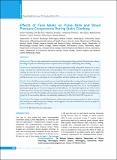Please use this identifier to cite or link to this item:
https://hdl.handle.net/20.500.14356/912Full metadata record
| DC Field | Value | Language |
|---|---|---|
| dc.contributor.author | Chaudhary, Sonam | - |
| dc.contributor.author | Pun, Dilli Bahadur | - |
| dc.contributor.author | Shrestha, Prashanna | - |
| dc.contributor.author | Shrestha, Anshuman | - |
| dc.contributor.author | Gupta, Alka | - |
| dc.contributor.author | Shrestha, Rabindra Man | - |
| dc.contributor.author | Shrestha, Sujita | - |
| dc.contributor.author | Joshi, Subha | - |
| dc.contributor.author | Mahotra, Narayan Bahadur | - |
| dc.date.accessioned | 2023-04-05T07:15:51Z | - |
| dc.date.available | 2023-04-05T07:15:51Z | - |
| dc.date.issued | 2022 | - |
| dc.identifier.citation | ChaudharyS., PunD. B., ShresthaP., ShresthaA., GuptaA., ShresthaR. M., ShresthaS., JoshiS., & Bahadur MahotraN. (2022). Effects of Face Masks on Pulse Rate and Blood Pressure Components During Stairs Climbing. Journal of Nepal Health Research Council, 20(02), 494-498. https://doi.org/10.33314/jnhrc.v20i02.3848 | en_US |
| dc.identifier.issn | Print ISSN: 1727-5482; Online ISSN: 1999-6217 | - |
| dc.identifier.uri | http://103.69.126.140:8080/handle/20.500.14356/912 | - |
| dc.description | Original Article | en_US |
| dc.description.abstract | Abstract Background: The use of face masks has been associated with physiological changes in body. This study aims to know the changes in pulse rate and blood pressure components after wearing face masks during stairs climbing. Methods: An experimental study was conducted among 60 apparently healthy young adults between 18-35 years of age. The pulse rate and blood pressure of the participants were recorded during rest at ground floor and after climbing the stairs till 5th floor at brisk and regular pace without wearing the face masks. The uniform KN95 masks were distributed and proper coverage of nose, mouth and chin were ensured. After 5 minutes interval, the pulse rate and blood pressure were recorded again at rest in ground floor and after climbing stairs with use of KN95 masks. Results: At rest, the difference in mean pulse rate was statistically significant after wearing masks in participants between 21-25 years of age (86.46±14.59 bpm, p=0.014). After climbing the stairs, the mean pulse rate (131.16±18.48 bpm), mean systolic blood pressure (137.67±16.13 mmHg) and mean rate pressure product (182.87±41.70) were higher in participants (age group: 26-30 years) wearing masks and the difference was statistically significant (p=0.001; 0.013; 0.001respectively). During stairs climbing, the change in mean systolic blood pressure (32.66±16.73 mmHg), mean pulse pressure (43.77±24.64 mmHg) and mean rate pressure product (96.58±37.23) were higher in participants (age group: 26-30 years) and the difference was statistically significant (p=0.036; 0.047 and 0.009 respectively). Conclusions: The changes in systolic blood pressure, pulse pressure and rate pressure product are found to increase after wearing face masks during stairs climbing. It can be suggestive of increase workload to the heart by wearing face masks in addition to climbing the stairs. Keywords: Blood pressure; face masks; pulse | en_US |
| dc.language.iso | en | en_US |
| dc.publisher | Nepal Health Research Council | en_US |
| dc.relation.ispartofseries | April-June, 2022;3848 | - |
| dc.subject | Blood pressure | en_US |
| dc.subject | Face masks | en_US |
| dc.subject | Pulse | en_US |
| dc.title | Effects of Face Masks on Pulse Rate and Blood Pressure Components During Stairs Climbing | en_US |
| dc.type | Journal Article | en_US |
| Appears in Collections: | Vol 20 No 02 Issue 55 April-June, 2022 | |
Files in This Item:
| File | Description | Size | Format | |
|---|---|---|---|---|
| 3848-Manuscript-29704-1-10-20221103.pdf | Full Article. | 235.62 kB | Adobe PDF |  View/Open |
Items in DSpace are protected by copyright, with all rights reserved, unless otherwise indicated.
